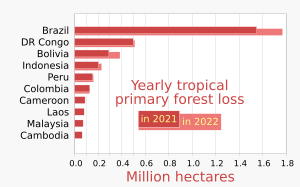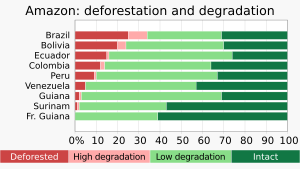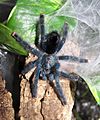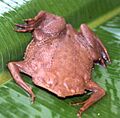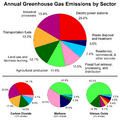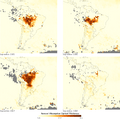Amazon rainforest facts for kids
Quick facts for kids Amazon rainforestPortuguese: Floresta amazônica Spanish: Selva amazónica |
|
|---|---|
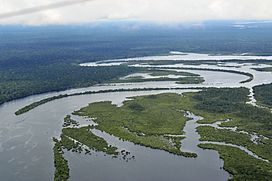
An aerial view of a floodplain in the Amazon rainforest near Manaus.
|
|
| Map | |

Map of the Amazon rainforest ecoregions (dark green) and the Amazon drainage basin (light green).
|
|
| Geography | |
| Location | Bolivia, Brazil, Colombia, Ecuador, French Guiana (France), Guyana, Peru, Suriname, and Venezuela |
| Coordinates | 3°S 60°W / 3°S 60°W |
| Area | 5,500,000 km2 (2,100,000 sq mi) |
The Amazon rainforest, also called the Amazon jungle or Amazonia, is a huge tropical rainforest in South America. It covers most of the Amazon basin, which is like a giant bowl that collects water. This basin is about 7,000,000 km2 (2,700,000 sq mi) big! The rainforest itself covers about 6,000,000 km2 (2,300,000 sq mi) of this area.
This amazing forest stretches across nine different countries. Most of it (60%) is in Brazil. Peru has the next biggest part (13%), then Colombia (10%). Smaller parts are in Bolivia, Ecuador, French Guiana (part of France), Guyana, Suriname, and Venezuela. Some countries even have regions named "Amazonas" after the forest.
The Amazon is super important because it's more than half of all the rainforests left on Earth! It's the biggest and has the most variety of life (called biodiversity) of any tropical rainforest in the world. Scientists think there are about 390 billion trees there, from around 16,000 different kinds!
Over 30 million people live in the Amazon. These people belong to 350 different groups. Many Indigenous groups have lived there for a very long time. About 9% of the people in the Amazon are Indigenous. Some groups still live very separate from the outside world.
Sadly, a lot of the forest is being cut down. This is called deforestation. Cutting down trees can actually cost more money in the long run than the things people get from the cleared land. In 2023, the World Bank suggested ways for people to make a living in the Amazon without cutting down trees.
Contents
- Where Did the Name "Amazon" Come From?
- A Look Back in Time: History of the Amazon
- Where is the Amazon and What's it Like?
- Amazing Life in the Amazon: Plants and Animals
- Losing the Forest: What is Deforestation?
- Protecting the Amazon: Conservation and Our Climate
- Related pages
- Images for kids
- See also
Where Did the Name "Amazon" Come From?
The name Amazon has a cool story. It comes from a Spanish explorer named Francisco de Orellana. Long ago, he was in a battle with some local tribes, like the Tapuyas. He noticed that the women of these tribes fought bravely alongside the men.
This reminded Orellana of the Amazons. These were warrior women in ancient Greek mythology. So, he named the river and the forest "Amazonas" after these legendary fighters.
A Look Back in Time: History of the Amazon
Early People and Big Surprises
People have lived in the Amazon for a very, very long time. Scientists found proof of this at a place called Caverna da Pedra Pintada. People have lived there for at least 11,200 years! Over thousands of years, people built settlements. They often lived around the edges of the forest.
For a while, many experts thought the Amazon rainforest was always a wild place. They believed only a few people lived there. They thought the soil was too poor for farming to support big communities.
However, newer discoveries have changed this idea! Archaeologists now think the Amazon was actually home to many people. For example, in Ecuador, they found ancient sites in the Upano Valley. These sites are older than any other known complex societies in the Amazon. It's possible that millions of people lived in the Amazon around the year 1500. Some even lived in large villages.
When Europeans Arrived
The first European to travel all the way down the Amazon River was Francisco de Orellana in 1542. He said he saw large, well-organized towns and farms along the river. For a long time, people thought he was making it up. But now, some evidence suggests he might have been telling the truth!
These civilizations were likely hit hard by diseases. Diseases like smallpox were brought by Europeans. These diseases spread quickly and caused many deaths. This was because the local people had never been exposed to them before.
The idea of "lost cities" in the Amazon fascinated explorers. One such explorer was Percy Fawcett in the early 1900s. He searched for a place he called the City of Z. Sadly, he disappeared on his last trip.
Clues from the Past
Since the 1970s, parts of the forest were cleared. This led to the discovery of amazing patterns on the ground. These are called geoglyphs. These large shapes were made between 1 AD and 1250 AD. They are more proof that organized societies lived there.
Scientists also found out that the Amazon rainforest isn't just a "wild" place. People have been shaping it for at least 11,000 years! They used smart farming methods like forest gardening. They also created super-rich soil called terra preta. This special soil helped them grow food in places where it was usually difficult. So, large parts of the Amazon might actually be ancient managed landscapes, not just untouched nature. In 2003, researchers found remains of large settlements with roads and plazas in the Xingu region.
Life and Conflicts
Life in the Amazon wasn't always peaceful. Some tribes, like the Jivaro, were known for fighting with their neighbors. The Munduruku were also a powerful tribe. However, other groups, like the Xingu, were generally peaceful.
During the Amazon rubber boom, rubber from trees became very valuable. Many Indigenous people suffered during this time. Diseases brought by outsiders, like typhus and malaria, caused the deaths of around 40,000 native Amazonians.
Protecting Indigenous Lands
In the 1950s, a Brazilian explorer named Cândido Rondon and the Villas-Bôas brothers worked hard to protect Indigenous people. Their efforts led to the creation of the first Brazilian National Park for Indigenous people. This was the Xingu National Park, created in 1961. This was an important step in recognizing and protecting the rights and lands of Indigenous communities.
Where is the Amazon and What's it Like?
Finding the Amazon on a Map
The Amazon rainforest isn't in just one country. It's shared by nine countries in South America!
- Most of it (58.4%) is in Brazil.
- Peru has the next biggest piece (12.8%).
- Colombia has 7.1%.
- Smaller parts are in Bolivia, Venezuela, Guyana, Suriname, French Guiana (part of France), and Ecuador.
How the Rainforest Formed
The Amazon rainforest is incredibly old! Scientists think it started forming during the Eocene era. This was between 56 million and 33.9 million years ago. This happened after the Atlantic Ocean got wider. This helped create a warm and wet climate perfect for a rainforest. The rainforest has been around for at least 55 million years!
Even when the Earth went through ice ages, most of the Amazon stayed as a rainforest. This allowed many different types of plants and animals to survive and develop over millions of years.
Millions of years ago, the land where the Amazon is now was different. The water in the western part flowed towards the Pacific Ocean. But then, the huge Andes Mountains started to rise. This created a giant basin that filled up with water, like a massive lake. Eventually, about 5 to 10 million years ago, this water broke through a barrier of land. This formed the Amazon River system we know today.
Scientists have found evidence that the amount of rain and the types of plants in the Amazon have changed over the last 21,000 years. It was probably drier back then, with less rainforest cover. Today, the Amazon gets about 9 feet of rain every year!
Surprising Helper: Dust from the Sahara Desert
Here's a really cool fact: dust from the Sahara desert in Africa actually helps feed the Amazon rainforest! More than half of the dust that fertilizes the Amazon comes all the way from a place called the Bodélé depression in Chad.
This dust contains phosphorus. Phosphorus is like a vitamin for plants and helps them grow. Every year, winds carry millions of tons of this dust across the Atlantic Ocean. NASA's CALIPSO satellite has measured this. It found that about 182 million tons of dust leave the Sahara each year. Around 22 million tons of this dust, full of phosphorus, falls over the Amazon basin. This replaces the phosphorus that gets washed away by rain and floods.
So, a desert on one side of the world helps keep a rainforest alive on the other side! Phosphorus for the Amazon also comes from smoke from fires in Africa.
Amazing Life in the Amazon: Plants and Animals
Tropical rainforests are bursting with life. The Amazon is the champion! It has more different kinds of plants and animals (this is called biodiversity) than any other place on Earth. In fact, one out of every ten known species in the world lives in the Amazon rainforest!
Imagine this:
- About 2.5 million species of insects buzz, crawl, and fly around.
- There are tens of thousands of different plants.
- Around 2,000 kinds of birds and mammals call it home.
So far, scientists have officially named and classified:
- At least 40,000 plant species
- 2,200 kinds of fish (that's one in five of all fish species in the world!)
- 1,294 bird species (one in five of all bird species!)
- 427 mammal species
- 428 amphibian species (like frogs and salamanders)
- 378 reptile species (like snakes and lizards)
And that's not all! In Brazil alone, scientists think there could be between 96,660 and 128,843 different kinds of invertebrates. These are animals without backbones, like insects and spiders.
The variety of trees is incredible. One study in Ecuador found over 1,100 tree species in an area just a quarter of a square kilometer! All those plants weigh a lot. One square kilometer of the Amazon can have about 90,790 tonnes of living plants. Scientists estimate there are about 16,000 different tree species in the whole Amazon region.
The leaves on the trees even change with the seasons. During the dry season, when there's more sunlight, the trees grow more leaves. Then, in the wet season, when it's cloudier, they lose some. This helps them balance how much energy they make and use.
Did you know that every hectare (about the size of two football fields) of the Amazon rainforest contains around 1 billion invertebrates? That's a lot of tiny creatures!
Here's a peek at how many species you might find in one hectare:
| Type of organism | Number of species per hectare |
|---|---|
| Birds | 160 |
| Trees | 310 |
| Epiphytes (plants that grow on other plants) | 96 |
| Reptile | 22 |
| Amphibians | 33 |
| Fish | 44 |
| Primates (monkeys and their relatives) | 10 |
Watch Out! Some Amazon Creatures Can Be Dangerous
While the Amazon is beautiful, it also has some creatures you need to be careful around. Some of the biggest hunters include the black caiman (a type of alligator), jaguar, cougar, and the giant anaconda snake.
In the rivers, electric eels can give a strong shock. And everyone knows about piranhas, which can bite humans. Some colorful poison dart frogs have toxins in their skin. There are also tiny dangers, like parasites and insects that can carry diseases. Vampire bats live here and can spread rabies. It's also possible to get diseases like malaria, yellow fever, and dengue fever in the Amazon.
Sadly, the amazing biodiversity of the Amazon is in danger. The biggest threats are losing habitat because of deforestation (cutting down trees) and an increase in fires. More than 90% of Amazonian plant and vertebrate animal species might have been affected by fires.
Losing the Forest: What is Deforestation?
Deforestation means cutting or clearing away forests. This is done to use the land for other things. The main reasons for deforestation in the Amazon are people moving in and developing the land for farming, ranching, and other activities.
By 2022, about 20% of the Amazon rainforest had already been cut down. Another 6% was very badly damaged. Some scientists worry that if we lose just a little more, around 20-25% in total, parts of the Amazon could reach a tipping point. This means it could change from a rainforest into a drier, savanna-like area. This change wouldn't happen overnight, but over many years.
How Deforestation Started and Grew
Before the 1960s, it was very hard to get deep into the Amazon rainforest. So, most of it was untouched. In the 1960s, people started creating farms using a method called slash and burn. This is where they cut down trees and burn them to clear land for crops. But the soil in the Amazon isn't very rich for long. So, farmers often have to move to new areas and clear more land after a few years. This led to a lot of deforestation and damaged the environment.
In the 1970s, construction started on the Trans-Amazonian highway. This road was planned to go right through the rainforest. Luckily, the highway was never fully completed. This limited some of the damage it might have caused.
Between 1991 and 2000, the amount of forest lost in the Amazon grew a lot. Most of this cleared land (about 70%) was turned into pasture for cattle. In fact, 91% of the land deforested since 1970 has been used for raising livestock. Brazil is also a major producer of soybeans. However, new research shows that cutting down more rainforest actually leads to less rain in the area. This means farmers get smaller harvests. So, cutting down the forest for farming might not even be a good economic choice in the long run.
The need for land for soy farming has often been used as a reason for building new roads and transportation projects in the Amazon. These projects can open up the forest to more settlement and deforestation. From 2000 to 2005, the rate of deforestation was very high. Although it slowed down a lot between 2004 and 2014, it has unfortunately started to increase again.
Some government leaders, like Brazil's former President Jair Bolsonaro, supported making it easier to use forest land for agriculture. During his time in office, rules protecting the Amazon were often weakened. This led to more deforestation and use of its natural resources. In 2021, deforestation reached its highest point in 15 years.
Discovering fossil fuel (like oil and gas) in the Amazon has also led to more drilling. Oil companies often have to build new roads to get to the oil. This adds to deforestation. About 9.4% of the Amazon's land is affected by oil fields.
Mining for minerals is another big cause of deforestation. Around 17% of the Amazon Rainforest area is affected by mining activities. Things like tin, manganese, and copper are in high demand for new technologies. This has attracted many illegal miners to the Amazon. This causes more tree loss and other problems. Even hydropower dams, which create electricity from water, can cause significant issues in the Amazon.
Some international agreements, like a proposed trade deal between the European Union and Mercosur, have worried environmental activists. They fear such deals could lead to even more deforestation. This could happen by making it easier to sell products like Brazilian beef, which often comes from areas where forests were cleared.
A report in November 2021 from Brazil's INPE, using satellite images, showed that deforestation had increased by 22% compared to 2020. This was the highest level since 2006.
The 2019 Fires
In 2019, there was a shocking number of fires in Brazil. There were 72,843 fires in total! More than half of these were in the Amazon region. August 2019 had a record number of fires. At the same time, deforestation in the Brazilian Amazon had jumped by over 88% in June 2019 compared to the same month the year before.
The increase in fires happened when the Brazilian government relaxed some environmental protection rules. Before these rules were first put in place in 2008, the area affected by fire was also larger. As these fires get closer to the heart of the Amazon, they harm more and more plant and animal species.
Protecting the Amazon: Conservation and Our Climate
People who care about the environment (environmentalists) are very worried about the Amazon. They are concerned about losing the amazing biodiversity (all the different plants and animals) when the forest is destroyed. They are also worried about the release of carbon stored in the trees and plants. When forests are cut down or burned, this carbon goes into the atmosphere. This can make global warming worse.
The Amazon's evergreen forests are super important. They do about 10% of the world's work in turning sunlight into plant matter. They also store about 10% of all the carbon stored in Earth's ecosystems. That's a massive 1.1 × 1011 metric tonnes of carbon! For a long time, the Amazon rainforests were thought to be absorbing more carbon dioxide than they released. However, a 2021 report said that for the first time, the Amazon might be releasing more greenhouse gases than it's taking in. This is a big concern.
You might have heard that the Amazon produces a lot of the Earth's oxygen. While it does produce a lot, the forest also uses a lot of oxygen itself. So, the net amount of oxygen it adds to the atmosphere is close to zero. Its biggest role for the planet is storing carbon and being home to incredible biodiversity.
Some computer models predict that if the Earth keeps getting warmer and the Amazon gets much less rain, the rainforest might not be able to survive. It could almost completely disappear by the year 2100. This would have terrible effects on the economy, nature, and the services the rainforest provides. However, not all computer models agree on how rainfall in the Amazon will change. Some predict more rain, others less. What is clear is that climate change, along with deforestation, is a serious threat to the rainforest.
Back in 1989, scientists showed that protecting the rainforest makes good economic sense. They calculated that one hectare (about 2.5 acres) in the Peruvian Amazon could be worth $6820. This is if it's used sustainably for things like fruits, latex (for rubber), and some timber. If it's clear-cut for timber, it's worth only $1000. And if it's used for cattle pasture, it's worth just $148.
As forests are destroyed, Indigenous communities who live there are also disappearing or struggling to survive. Groups like the Urarina in Peru are fighting to protect their culture and their forest homes. Scientists are also studying the important relationship between Indigenous people and the animals and plants of the rainforest.
Good news! From 2002 to 2006, the amount of protected land in the Amazon rainforest nearly tripled. Deforestation rates dropped by up to 60%. About 1,000,000 km2 (250,000,000 acres) were set aside for conservation. Now, the total conserved area is about 1,730,000 km2 (430,000,000 acres).
There have been some legal victories too:
- In April 2019, a court in Ecuador stopped oil exploration in 180,000 hectares (440,000 acres) of the Amazon rainforest.
- In July 2019, the same court said the government could not sell forest land to oil companies.
In September 2019, the US and Brazil agreed to support private businesses developing in the Amazon. They pledged $100 million for a conservation fund. Brazil's foreign minister at the time said that allowing some economic development was the only way to protect the rainforest. This is a debated idea.
A study in 2009 found that if global temperatures rise by 4 °C, 85% of the Amazon rainforest could die. Even a 3 °C rise could kill 75% of it.
A newer study showed that if we plan to protect both freshwater and land ecosystems together, we can protect up to 600% more freshwater biodiversity!
Deforestation in the Amazon also affects the local climate. It was a major cause of a bad drought in Brazil in 2014–2015. This is because the forest releases a lot of moisture into the air. This helps create rain in Brazil, Paraguay, and Argentina. About half the rainfall in the Amazon area actually comes from the forests themselves!
In 2022, the highest court in Ecuador made an important decision. It said that no project can be carried out if it causes too much harm to the rights of communities and nature. It also said the government must listen to Indigenous peoples' opinions about projects on their land. Many people think this decision could have a big impact even outside Ecuador. Generally, ecosystems are healthier when Indigenous peoples own or manage the land.
Thanks to new conservation policies under President Luiz Inácio Lula da Silva of Brazil, deforestation in the Brazilian Amazon decreased by about 50% in the first 10 months of 2023 compared to 2022. This happened even though there was a very bad drought. Climate change, weather patterns like El Niño, and deforestation all make droughts in the Amazon more likely.
Overall, from January to November 2023, deforestation in the entire Amazon fell by 56% compared to the same time in 2022. This was mainly due to Brazil's efforts. Colombia, Peru, and Bolivia also reduced deforestation.
However, in 2023, while Amazon deforestation went down by 50%, vegetation loss in the nearby Cerrado (a savanna region) went up by 43%. Together, these two important areas lost 12,980 km² of natural vegetation. This is 18% less than in 2022, but still a very large area.
Using Satellites to Watch Over the Amazon
Using data from satellites (remote sensing) is a huge help for understanding and protecting the Amazon. Satellites can take pictures of the land, showing where forests are being cut down. This is often cheaper and more objective than trying to check everything on the ground, especially in such a huge area. Remote sensing is probably the best way to study the whole Amazon basin.
Indigenous tribes in the Amazon are also using this technology to protect their lands. They use handheld GPS devices and programs like Google Earth to map their traditional territories. This helps them show clear boundaries. This can protect their land from businesses that want to use it.
To understand how much carbon is stored in the Amazon and how much is released when trees are cut, scientists need to know how old different parts of the forest are. In 2006, a researcher named Tatiana Kuplich classified Amazon trees into four groups. She used different types of satellite data to do this.
Impact of Early 21st-Century Amazon Droughts
In 2005, parts of the Amazon had the worst drought in 100 years. Some worried that 2006 would be another drought year. One report said the forest, as it is, could only survive three years of drought. Scientists in Brazil warned that these droughts, plus deforestation, could push the rainforest to a "tipping point". This is where it would start to die and turn into savanna or desert. This would be disastrous for the world's climate.
A 2020 study found that about 40% of the Amazon rainforest is at risk of becoming a savanna-like ecosystem because of less rain. Another study showed that over three-quarters of the rainforest has been losing its ability to bounce back from disturbances since the early 2000s. This is a serious warning.
The World Wide Fund for Nature says that climate change and deforestation together make dead trees drier. This then fuels more wildfires.
In 2010, the Amazon had another very bad drought. It was even worse in some ways than the 2005 one. It affected a huge area of about 3,000,000 km2 (1,160,000 sq mi) of rainforest. In a normal year, the Amazon absorbs about 1.5 gigatons of carbon dioxide. But during the 2005 drought, it released 5 gigatons, and in 2010, it released 8 gigatons! There were also severe droughts in 2010, 2015, and 2016.
In 2019 Brazil's protections of the Amazon rainforest were cut. This resulted in a severe loss of trees. According to Brazil's National Institute for Space Research (INPE), deforestation in the Brazilian Amazon rose more than 50% in the first three months of 2020. This was compared to the same three-month period in 2019.
In 2020, a 17 percent rise was noted in the Amazon wildfires. This marked the worst start to the fire season in a decade. The first 10 days of August 2020 saw 10,136 fires. An analysis of government figures showed an 81 percent increase in fires in federal reserves. This was compared with the same period in 2019. However, President Jair Bolsonaro denied the existence of fires. He called it a "lie", despite the data produced by his own government. Satellites in September recorded 32,017 hotspots in the world's largest rainforest. This was a 61% rise from the same month in 2019. In addition, October saw a huge surge in the number of hotspots in the forest. More than 17,000 fires were burning in the Amazon's rainforest. This was more than double the amount detected in the same month last year.
Can We Have a Forest-Friendly Economy?
In 2023, the World Bank released a report. It said that the money lost due to deforestation in Brazil could be around 317 billion dollars per year. This is about 7 times more than the value of all the things produced by cutting down the forest! The report suggested ways to have a strong economy in the Amazon region without deforestation.
One idea is Silvopasture. This means farming in a way that includes trees, crops for animals to eat (forage), and grazing animals all together. This can help stop deforestation.
According to WWF (World Wide Fund for Nature), ecotourism could also help the Amazon. Ecotourism means travel that is good for the environment and local people. It's not very common in the Amazon yet. This is partly because people don't know much about where it can be done. Indigenous communities could also run ecotourism businesses to earn money. There are some community-based ecotourism projects. For example, in the Mamirauá Sustainable Development Reserve in Brazil and in the Peruvian Amazon.
In May 2023, Brazil's bank federation decided to create new rules for meatpacking companies. These companies will have to prove their meat doesn't come from illegally deforested areas. Banks won't give loans to companies that don't follow these rules. This decision came after the European Union decided to make similar rules to stop deforestation.
The Colombian government stated that deforestation in the Colombian Amazon fell by 70% in the first 9 months of 2023. This was compared to the previous year. This success is partly due to policies like paying local people to help conserve the forest.
Related pages
Images for kids
-
The Hoatzin is a unique bird found in the Amazon.
-
A Howler monkey – you can hear their calls from far away!
-
Heliconia flowers are bright and beautiful.
-
The Brown-throated sloth moves very slowly.
-
The Emperor tamarin has a cool mustache!
-
The Bald uakari monkey has a bright red face.
-
The Green anaconda is one of the world's largest snakes.
-
The Black caiman is a top predator in Amazon waters.
-
The Jaguar is a powerful big cat.
-
Bullet ants have a very painful sting!
-
Parrots gather at a clay lick in Yasuni National Park, Ecuador. They eat the clay to get minerals.
-
The Pipa pipa is a strange-looking frog. The female carries her eggs on her back!
-
Scarlet macaws are known for their bright colors.
-
The Titan Beetle is one of the largest beetles in the world and lives in the Amazon.
-
This photo shows deforestation in the Maranhão state of Brazil in 2016.
-
Fires and deforestation in the state of Rondônia.
-
This map shows where uncontacted tribes were thought to live around the beginning of the 21st century. Many of these groups live in the Amazon.
-
The Guiana Amazonian Park in French Guiana is a large protected area of rainforest.
-
Bates's 1863 The Naturalist on the River Amazons
-
Manaus is the biggest city in the Amazon basin, with over 2 million people.
-
The Yanomami are one of the many Indigenous groups living in the Amazon rainforest. There are about 32,000 Yanomami people.
-
These are members of an uncontacted tribe found in the Brazilian state of Acre in 2009. They choose to live separately from the outside world.
-
An airplane view of the Amazon rainforest near the city of Manaus.
-
Looking down on the Amazon rainforest near Manaus.
-
Deforestation in the Amazon rainforest is a big threat to many animals, like tree frogs. These frogs (this one is a giant leaf frog) are very sensitive to changes in their home.
-
Look at this giant, twisted liana (a type of woody vine) in western Brazil!
See also
 In Spanish: Amazonia para niños
In Spanish: Amazonia para niños


